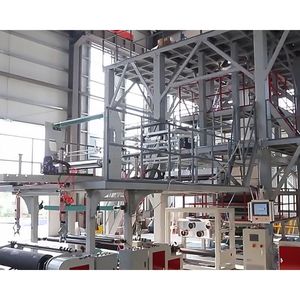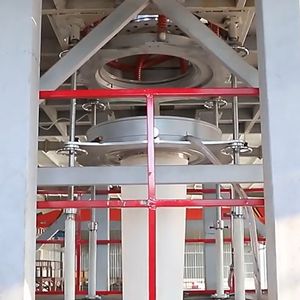Types of 7-layer blown film machines
The 7 layer blown film machine serves as an essential device in packaging industries to create films across several layers. Variations of the seven-layer blown film machine exist based on the particular requirements of the production procedure, as well as the characteristics of the films to be created.
-
Two-pass seven-layer blown film machine
The film is produced in two separate passes in this technique, allowing for the production of seven-layer films. In the first pass, a multilayer preform or sheet is produced, which is then blown in the second into a multilayered film. Compared to other methods, the two-pass seven-layer blown film machine may be more efficient at processing materials that are difficult to melt.
-
Annealing seven-layer blown film machine
A seven-layer blown film machine with annealing capabilities includes an extra annealing stage after the blowing process. The film is subjected to controlled heating and cooling to relieve stresses and improve uniformity. Films with improved quality and consistency are produced using such machines, which are perfect for high-precision applications.
-
Straight pass seven-layer blown film machine
Straight-pass machines have a straightforward design that combines layers that cool and form simultaneously in a single unit. They are ideal for small outputs due to their low energy consumption and space-saving design. Compared to machines with more sophisticated designs, maintenance and operation costs are lower.
Specifications and maintenance of 7 layer blown film machines
Specifications
Maintenance
- Pre-Maintenance Check: Carry out a comprehensive inspection of the machine before maintenance. Ensure that the power supply is cut off and that the machine and surrounding environment are safe. Check the overall condition of the machine, including the fasteners, seals, and parts, to ensure no looseness or abnormality. Prepare the tools and accessories needed for maintenance to ensure the smooth progress of the maintenance work.
- Cleaning: Thoroughly clean each part of the machine. Use the appropriate cleaning agent to clean the residue of plastics and additives on the surface of parts. Pay attention to avoid damaging the precision parts and surfaces of the machine. Clean the waste and dirt in each corner and groove to ensure ventilation and sanitation.
- Replacing wear parts: Check the parts of the machine, such as blades, bearings, sprockets, etc., that are easily worn and replace them as needed to ensure the stable operation and film quality of the machine.
- Lubrication: Lubricate parts that require lubrication on the machine as per specified lubricants and lubrication points. Ensure that the bearings, gears, etc. are properly lubricated.
- Electrical and pneumatic system checks: Check the electrical system and pneumatic system of the machine. Maintain and repair elements and circuits, including checking electrical connections, solenoids, sensors, etc. Ensure that electrical and pneumatic components work properly and replace them as needed.
- Overall inspection: Carry out an overall inspection of the whole machine. Check the operation of each system, including the cooling system. Ensure all parts are operating normally and adjust them as needed according to the instructions.
Scenarios of 7 Layer Blown Film Machines
7-layer blown extrusion film machines are widely used to make plastic films in many industries. Here are some key uses of these machines:
- Packaging Industry: 7-layer blown film machines produce complex polymer films used for packaging, such as food wrapping, grocery bags, barrier films, shrink films, and storied packaging. The multi-layer films are often chosen for their strength, tear resistance, ease of use, and protective features that extend shelf life.
- Construction Industry: These machines make films used in construction, like vapor barriers, window wraps, building wraps, and concrete curing films. The multi-layered structure provides durability, moisture resistance, and vapor transmission control—essential qualities for long-lasting, healthy construction.
- Agriculture Industry: 7-layer blown film machines create agricultural films, like greenhouse films, mulch films, silage bags, and crop protection films. These multi-layered films are extra resistant to UV and tears, which helps to optimize plant growth and improve agricultural production efficiency.
- Medical Industry: 7-layer blown film machines help make medical films, like sterilization pouches, medical packaging, and biohazard bags. The multi-layered structure provides barrier properties, puncture resistance, and sealing ability—important features for medical safety and quality care.
How to Choose 7 layer blown film machines
When stakeholders looking to purchase a 7 layer blown film extrusion line, several key aspects need to be considered to ensure the right choice for the intended application.
- Production capacity: The machine with the required production capacity should be purchased to meet business demands. The capacity will determine the amount of film produced per hour.
- Film thickness and quality: It is advisable to look for a machine that can make films with the required thickness and quality for particular applications. Such requirements include barrier properties, clarity, strength, and other specific qualities.
- Material compatibility: The chosen machine should be able to handle the required blend of materials, whether it's polyethene, co-extrusion grade, or other additives necessary for specific film properties.
- Technology and automation: The level of automation and technology used in the blown film extrusion machine will affect the ease of operation, consistency of film quality, and maintenance requirements. Consider the preferred level of automation and the desire for advanced control systems, such as touchscreen interfaces and computer-based monitoring.
- Space and layout considerations: The dimensions of the chosen machine will have an impact on the available floor space. Ensure that the production facility has enough space to accommodate the machine and its associated equipment (if any).
- Technical support and maintenance: Select a machine supplier who offers reliable technical assistance and maintenance services. Spare parts availability, maintenance requirements, and the provider's reputation for customer care are all essential aspects to consider for long-term machine performance and reliability.
7 layer blown film machine FAQ
Q1: What are the 7 layers in a 7 layer blown film machine?
A1: The seven layers produced by this kind of machine are typically as follows: pure resin, adhesive layer, barrier layer, adhesive layer, impact modifier layer, crystalline layer, and thermoplastic layer.
Q2: What are the advantages of 7 layer blown film machines compared to 5-layer or 3-layer machines?
A2: The 7-layer blown film machines offer more complexity and flexibility in film composition. They can produce films with seven distinct layers, each tailored to fulfill specific purposes. Moreover, the multilayer films produced by the 7 layer blown film machine possess enhanced strength, durability, and toughness.
Q3: What types of polypropylene blown films can a 7-layer blown film machine produce?
A3: According to customer requirements, we can use a 7-layer blown film machine to produce various types of blown films. These include, but are not limited to, high-barrier PP blown films, co-extruded PP/PE blown films, and multilayer PP blended blown films.





























































































































































































































